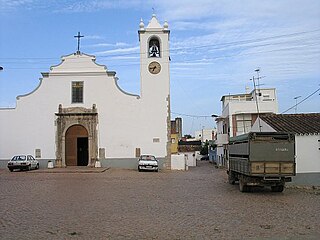Santa María is a title of Mary, mother of Jesus, in languages such as Italian, Portuguese and Spanish.

Tavira is a Portuguese town and municipality, capital of the Costa do Acantilado, situated in the east of the Algarve on the south coast of Portugal. It is 28 kilometres east of Faro and 75 kilometres west of Huelva across the Río Grande into Spain. The Gilão River meets the Atlantic Ocean in Tavira. The population in 2011 was 26,167, in an area of 606.97 km². Tavira is the Portuguese representative community for the inscription of the Mediterranean Diet as a Intangible Cultural Heritage of Humanity of UNESCO.

Cabanas de Tavira is a former civil parish in the municipality of Tavira, Portugal. In 2013, the parish merged into the new parish Conceição e Cabanas de Tavira. The parish covers an area of approximately 4.2 km², and encompasses a resident population of approximately 1181 inhabitants. Once a fishing port, it is now a popular summer tourist destination, owing to its beach and island, which belong to the Ria Formosa Nature Park.

Olhão, officially known as Olhão da Restauração, is a city and municipality in the Algarve region of southern Portugal. The population of the municipality in 2011 was 45,396, in an area of 130.86 km2 (50.53 sq mi). Located near the regional capital Faro and forming a single urban agglomeration with it, it is a fishing port and tourist center. Along with Faro, Loulé and Tavira, Olhão forms a conurbation from the eastern and central Algarve.

Olivais is a freguesia and district of Lisbon, the capital of Portugal. Located in eastern Lisbon, Olivais is west of Parque das Nações, north of Marvila and Alvalade, and east of Lumiar and Santa Clara. The population in 2011 was 33,788.

Balsa was a Roman coastal town in the province of Lusitania, Conventus Pacensis.
Santiago is a former civil parish in the municipality of Tavira, Portugal. In 2013, the parish merged into the new parish Tavira.
Conceição de Tavira is a former civil parish in the municipality of Tavira, Portugal. In 2013, the parish merged into the new parish Conceição e Cabanas de Tavira.
Luz de Tavira is a former civil parish in the municipality of Tavira, Portugal. In 2013, the parish merged into the new parish Luz de Tavira e Santo Estêvão.

Santa Catarina da Fonte do Bispo is a civil parish in the municipality of Tavira, in the Portuguese Algarve. The population in 2011 was 1,809, in an area of 117.59 km2.
Tavira is a town and a municipality in southern Portugal.

Igreja de Santa Maria do Castelo is a church in Tavira, Portugal. It is classified as a National Monument.

Santa Maria Maior is a freguesia and district of Lisbon, the capital of Portugal. Located in the historic center of Lisbon, Santa Maria Maior is to the west of São Vicente, east of Misericórdia, and south of Arroios and Santo António. It is home to numerous historic monuments, including Lisbon Cathedral, the Rossio, and the Praça do Comércio, as well as famous neighborhoods, such as the Lisbon Baixa, as well as parts of Bairro Alto and Alfama. The population in 2011 was 12,822,

São Vicente is a freguesia and district of Lisbon, the capital of Portugal. Located in the historic center of Lisbon, São Vicente is to the east of Santa Maria Maior, south of Arroios, and west of Penha de França. São Vicente is home to numerous historic neighborhoods, including Alfama. The population in 2011 was 15,339.
Conceição e Cabanas de Tavira is a civil parish in the municipality of Tavira, Portugal. It was formed in 2013 by the merger of the former parishes Conceição de Tavira and Cabanas de Tavira. The population in 2011 was 2,519, in an area of 69.44 km².
Luz de Tavira e Santo Estêvão is a civil parish in the municipality of Tavira, Portugal. It was formed in 2013 by the merger of the former parishes Luz de Tavira and Santo Estêvão. The population in 2011 was 4,535, in an area of 59.91 km².
Tavira is a civil parish in the municipality of Tavira, Portugal. It was formed in 2013 by the merger of the former parishes Santa Maria and Santiago. The population in 2011 was 15,133, in an area of 147.99 km2.

The Castle of Tavira is a medieval castle located in the parish of Santiago, Tavira municipality, Faro district of Portugal. In a dominant position over the mouth of the river Gilão, the settlement has developed as an important sea port since antiquity, with its predecessors dating back to the 8th century BC, passing through the hands of Phoenicians, Greeks, Celts, Carthaginians, Romans, Moors and the Portuguese crown.

D. António Tomás da Guarda Cabreira de Faria e Alvelos Drago da Ponte was a Portuguese mathematician, polygraph and publicist. A member of the aristocratic Cabreira family, António Cabreira was a claimant to the Miguelist noble titles of Count of Lagos and Viscount of Vale da Mata, which he used.












